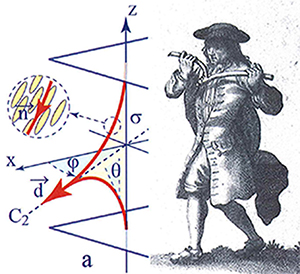EPJ E Highlight - Dowsing for electric fields in liquid crystals
- Details
- Published on 03 June 2019

The orientation of the ordered molecules that make up nematic liquid crystals can change under electric fields, and can be used to detect subtle electrical effects.
You may not know it, but you probably spend several hours a day looking at nematic liquid crystals; they are used in virtually every smartphone, computer and TV screen. They are liquids composed of elongated molecules, which in some situations can be oriented in a curious way termed the 'dowser texture', which is sensitive to external conditions. Physicists Pawel Pieranski of the Universite Paris-Sud, Paris, France and Maria Helena Godinho of Universidade Nova de Lisboa, Lisbon, Portugal have now published a paper in EPJ E that shows that the dowser texture responds to electric fields in different ways in different nematic materials.
In a dowser texture, a liquid crystal is squeezed between two glass plates so that the molecules closest to the plates are perpendicular to them but point in opposite directions. In the bulk, on the way from one plate to the other one, the molecules rotate 180° so that if you follow the change in their direction with a line you end up with a pointed shape resembling the Y-shaped wooden rods used by dowsers in centuries past to locate groundwater, hence the name – the dowser texture.
The 'tip' of the dowser texture is free to rotate rather like a weathervane and can thus act as a sensitive probe. Its direction is sensitive to the direction of an electric field, with the tip pointing either from the positive to the negative electrode (parallel) or vice versa (antiparallel).
In their work, Pieranski and Godinho observed different dowser textures in electric fields under polarised light and showed them to be antiparallel to the field in the liquid crystal MBBA, which is in line with previous experiments, but unexpectedly parallel in 5CB. They explained this in terms of the phenomenon of 'electro-osmosis': a liquid flow that is induced by an electric current. Thus, the dowser texture can also be used to detect electro-osmosis.
Pieranski and Godinho also found that the dowser texture can contain defects, which they suggest may have applications as microscopic carriers.
P. Pieranski and M.H. Godinho (2019), Electro-osmosis and flexo-electricity in the dowser texture, Eur. Phys. J. E 42:69. DOI 10.1140/epje/i2019-11832-9




